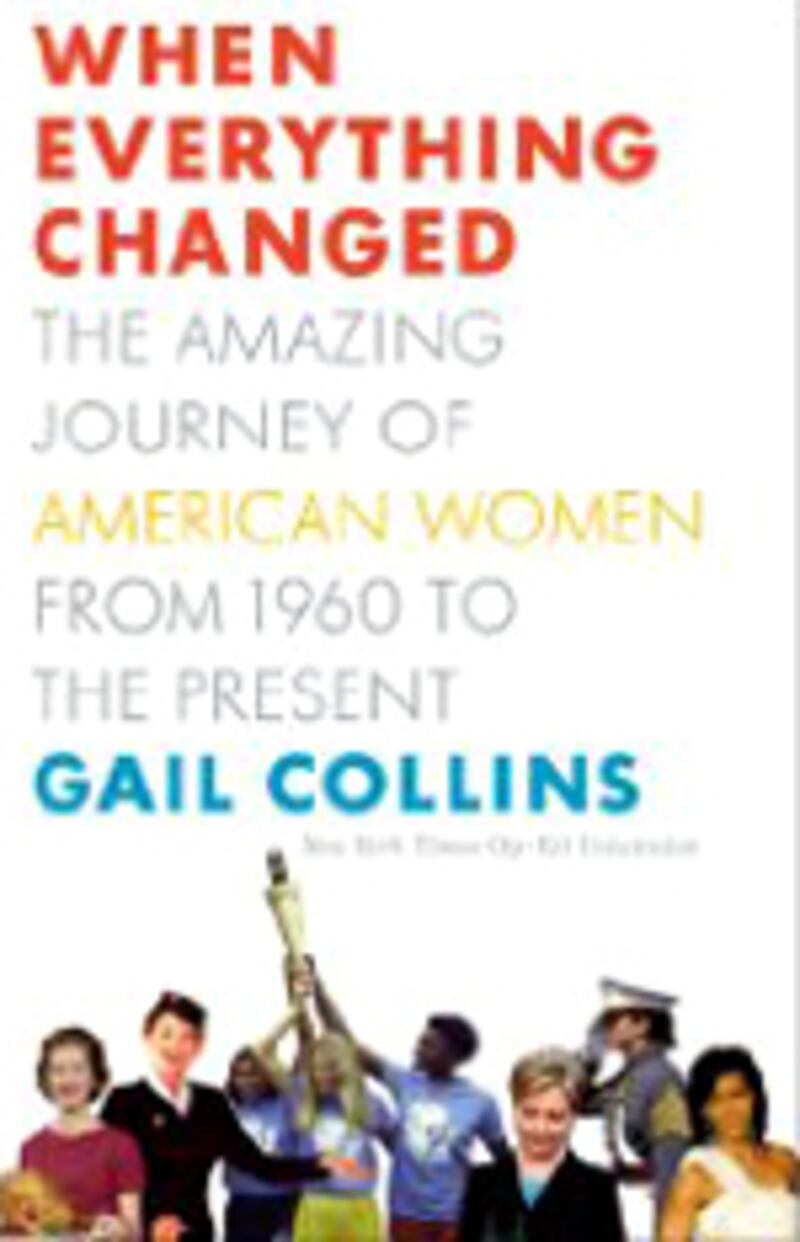
From the first pages, Gail Collins’ When Everything Changed offers the frisson of pleasurable horror in contemplating what things were like before they did change for women. Take the Cherry Ames, Student Nurse books, which in the deep 1950s were the one source of career inspiration for teenage girls—along with novels about stewardesses and girl detectives. Smack in the middle of the feminine mystique, Collins points out, when even Betty Friedan thought that American housewives’ leisure left them nothing to do but shop, chauffeur children, drink, and pop pills, items like diaper pails were the norm—white enameled garbage cans that held the dirty diapers until washday, when the housewife poured in boiling water and scrubbed them by hand, for all the world as if she were a farm wife bending over a washtub.
She thinks back—a bit ruefully—to the young 1970s feminists who assumed that somehow American society would accommodate the revolution they unleashed. “They had not considered the possibility that society might remain pretty much the same as always.”
Collins never writes about herself, but vivid recollection suffuses the details and drives her book’s arc of hopefulness. Like me, she is from the generation who lived through the 1950s as girls. We were not the foot soldiers of the feminine mystique but the slacker draftees, doing our best to stay clear of those smelly diaper pails, yearning for some vague glamour that lay beyond being a nurse or a secretary. Then the 1960s came, feminism arrived, and history turned on a dime. For a time the dreamy girls-becoming-women were fortune’s favorites. Doors cracked open and female ambition exploded, leaving Cherry Ames and her ilk in the dust. What any woman who is now past 50 got from those years was a life she never expected to live. Collins, who would have started out learning secretarial skills like any middle-class female, ended up the first woman to edit the editorial page of The New York Times, an inconceivable destiny for a girl in 1957 or, for that matter, 1965. You could hardly live through these years without acquiring an abiding wonder at how much things can change, along with a deep reserve of disappointment at how little they really did in the end.

For Collins, what caused the transformation was women’s increasing presence in the paid labor force, a proportion that has climbed steadily since 1940 (and continues to grow today). By the 1960s, frank prejudice against working women—sometimes nasty, sometimes jovial, always intransigent—came up against assumptions about fairness that the civil-rights movement was already burning into the nation’s psyche. Title VII of the Civil Rights Act of 1965, which forbade job discrimination on the basis of sex, was introduced in the House as joke by a Dixiecrat congressman who was using it to mock the entire notion of job equity as patently ridiculous. But Title VII proved to be a law that far outstripped its origins. Working women hurried to make use of it, over the years, fighting in court and out of court, to make it count. Lilly Ledbetter is the latest litigant in a line that stretches back to the 1960s; her unsuccessful 2007 suit against Goodyear Tire for sex discrimination led to the Ledbetter Fair Pay Act, the first bill President Obama signed when he took office.
But it’s more than individual victories that count. The principle of women’s merit and just deserts has changed the terms of conflict. Today, you’d be hard put to find an American who thinks women should be held back, or down, simply because they’re female. Even Ledbetter’s employer argued on the basis of technicality, not substance, that she was too late in filing her complaint. Compare this to the 1960s, when women worked their entire lives as teachers in systems that openly paid male teachers more. Today’s female judges and attorneys, physicians and college professors, business executives and office managers, and, yes, editors and writers for The New York Times—as well as the occasional electrician and plumber—are all indebted to these years. But of course, what people say about equal pay doesn’t begin to address the problems of working women having children, or women who bump up against a glass ceiling, or, increasingly, a job market that these days has a brutal impact on just about everyone.
The last third of Collins’ book addresses the confusion that set in during the 1980s, when the Reagan administration gave governmental support to the backlash. “You can pick your own vision,” Collins concludes. “Best of times or worst of times.” She thinks back—a bit ruefully—to the young 1970s feminists who assumed that somehow American society would accommodate the revolution they unleashed. “They had not considered the possibility that society might remain pretty much the same as always,” opening the door to women in work and education and leaving it at that. There was no support for childcare forthcoming, few alterations in the domestic division of labor that made housework and parenting female jobs, and in practice, inequities in pay and promotions only lessened slightly. Divorces increased, but hardly as a sign of women’s emancipation: Researchers began to notice that men’s standard of living rose significantly when they left their marriages, while women’s and children’s plummeted.
So how much has really changed? Collins has no ready answers, which is a virtue. Instead she presents a historical record at once dismaying and encouraging. Here are low points of the 1980s and beyond, like the controversy over surrogate mothers and Baby X—the first big blowup over the new reproductive technology. She revisits the fury over the “Mommy Track” and the many go-rounds of the full-time motherhood vs. full-time work argument. She traces the emergence of the exhausting routine of women who plunged into demanding jobs, financial responsibilities, and family life with no government supports—circling from “home, to daycare, to work, to daycare, to home.” Here, too, are some delectably horrible artifacts of the backlash years, including the 1986 study that supposedly demonstrated clearly that a 35-year-old college graduate had a better chance of being killed by a terrorist than of finding a husband. Yet through these dismal episodes, Collins weaves the stories of women she interviewed—some famous, some not—packed with victories small and large, successes intimate and public, and marked more often than not with living happily ever after—love sought and won on better terms, good work expanding to fill a life, vindication of desires and yearnings once deemed insupportable for someone female.
The mixture of optimism and dismay gives When Everything Changed not only its lift and dry humor but also its sagacity, and explains something about the notable lack of lamentation and bitterness in Collins’ observations about gender today. You can’t imagine Collins, for example, endorsing this sentiment from a recent Times op-ed writer on the bad deal America has handed to Gen X women: “Progress for women has stalled. And attitudes have taken a giant leap backward.” Anyone whose future once included diaper pails could not write: “I never expected that we would be in this predicament.” It’s not that this writer was wrong: Forty years into “how everything changed,” American women are between a rock and a hard place, and we need all sorts of writing exposing their problems. But Collins gives us a longer view of history, which has the advantage of showing indisputably that when an old order crumbles, the depressing mess is still preferable to the tidiness of a once-immovable status quo.
Plus: Check out Book Beast for more news on hot titles and authors and excerpts from the latest books.
Christine Stansell is Stein-Freiler Distinguished Service Professor at the University of Chicago. Her book on the history of feminism will be published by Random House next year.






